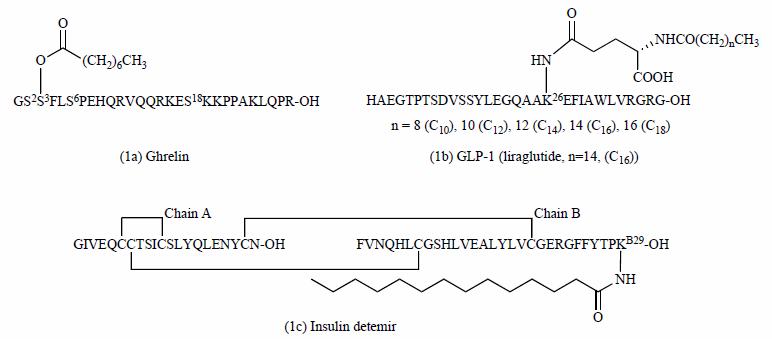Lipidation is a post-translational modification of peptides and proteins. Some nonribosomally synthesized bacterial antibiotics and ghrelin are naturally-occurring lipidated peptides. Peptide lipidation is a process in which a peptide molecule is attached to a lipid molecule. This modification can occur naturally in living organisms or can be performed artificially in the laboratory.
Peptide drugs offer many desirable drug properties such as potent bioactivity, high receptor binding affinity and specificity, and relatively low toxicity. However, most peptides are quickly degraded in serum and exhibit rapid clearance in vivo. Many strategies have been employed in an attempt to overcome these apparent disadvantages including lipidation, glycosylation, cyclization, backbone modification, unnatural or D-amino acid conjugation and PEGylation. Among these chemical modification methods, lipidation has proven to be one of the most robust strategies for the generation of new therapeutic peptide.
Four lipidized peptide drugs are currently approved for use in humans: two long-acting anti-diabetics human glucagon-like peptide-1 (GLP-1) analogue liraglutide and insulin detemir, and two antibiotics daptomycin and polymixin B. A number of lipidated peptides, lipoproteins and lipidated peptide vaccines are at different phases of clinical trials. As indicated in Table 1, lipidation was extensively exploited in the drug developments.
 Structures of ghrelin, GLP-1 (liraglutide) and insulin detemir (Zhang L, et,al. 2012)
Structures of ghrelin, GLP-1 (liraglutide) and insulin detemir (Zhang L, et,al. 2012)
Table 1
| Type | Peptides |
| Fatty acid | Enkephalin, Galanin, GIP, GLP-1 (liraglutide), hPP, IGF1R JM inhibitor, Insulin; Leuteinizing hormone releasing hormone (LHRH), NPW, NPY, NT, RC-160, STAT3, Tetragastrin, Thyrotropin releasing hormone (TRH) |
| Amino fatty acid | Conotoxin SIIIA, Ghrelin, Liraglutide, Met-Enkephalin, TAN-1511A, Tenecin-1 |
| Acidic fatty acid (dicarboxylic acid) | Growth hormone-releasing hormone antagonists (GHRH) |
| Halo-fatty acid | Ghrelin |
| Lipoamino acid | Core peptide, Thymopentin TP5, Peptide A2, Polycationic lipophilic core dendron excipient |
| Alkyl ether (O-, S-) | Angiotensin |
| Alkyl amine | Compound 3 |
| Adamantylation | Ghrelin |
| Cholesterol | C34, Insulin |
Lipidation can be classified into three types based on lipid bond formation methods with peptide chain or side chains: amidation, esterification (S- or O-) and S-bond (ether or disulfide) formation. Amidation and O-esterification are strong and irreversible covalent bonds, whereas S-esterification and disulfide bond formation are weak and reversible covalent bonds.
References